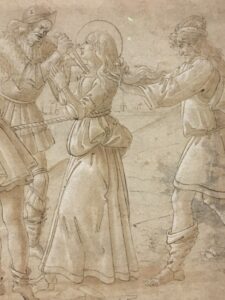Summer 2024
Summer 2024
Irving Penn Photography Exhibition
De Young Museum
San Francisco, California
De Young Art Museum’s new photography exhibition is amazing and has attracted many visitors from California, other states and around the world to visit the museum and enjoy their experience of learning about the photography. Irving Penn had a unique style and created lots of impressive and everlasting photos that fascinating the viewers.
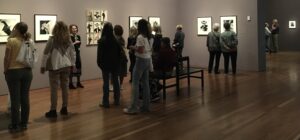
The American photographer, Irving Penn was one of the earliest photographers who used grey or white backdrop in his photography style. In his photos he used lightening conditions to create powerful images of both the famous and the ordinary people around the world. In his trip to France he made many notable photographs. Four wonderful and everlasting ones are: the photograph of Audrey Hepburn that shows her unique natural charm, the photo of Jean Cocteau, the French intellectual that looking with his intelligent and piercing eyes, the stunning portrait of Picasso that focusing on the gaze of his left eye, and finally the photo of Ingmar Bergman that is symbolic and striking.


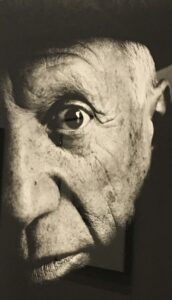

The talented photographer, Irving Penn made many trips around the world and took many striking photos. The notable ones are those that he created while he was in Cuzco, Peru. According to the scholar and the expert of the photography in Cuzco, Dr Andrés Garay Albújar, the photography in Cuzco began in the 19th century with the scientific purpose of portraying archeological ruins and then several decades later, it was the arrival of the commercial photography of indigenous people. Penn created an extraordinarily powerful photo of a newspaper boy in 1948 in Cuzco.

And the following year he made a series of photos called “Christmas at Cuzco” that are amazing especially that one showing the young couple in the colorful dress and impressive look.

In 1971, Irving Penn went to Morocco and created many interesting photos of Moroccan guedra dancers: they are erotic dancers in veils; they must be single, divorced or widowed to be allowed to remove their veils rhythmically during the dance; the married women are not allowed to remove their veils.

A group of amateur photographers were visiting the exhibition and were thrilled about their new experience; they were discussing the special techniques Penn used in his projects. Ms Lanciani who joined the group three years ago said: “Today I learned more about photographs than during attending the photography class for six months.”©CTR Press

Summer 2024:
SFMOMA
San Francisco, California
On the seventh floor of the museum, there’s an interesting exhibition called “Art of Noise” it shows the connection between music and design by presenting about 900 products and graphics. It shows how an image can change the perception of music. A graphic design has the power to compliment the sound and help the listeners in the journey.

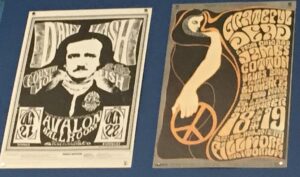

The controversial mirror room by Kusama is on display on the 6th floor. The small space of the multicolored light room was somehow suffocating to some visitors and intimidating to the kids. Linda, a graphic artist who was visiting the installation felt suffocated and left the space to visit other exhibitions in the museum. A family with two small children also had to discontinue their visit of Kusama exhibition because the small kid was scared and started to cry. It caused a debate among the visitors about art. Can an unpleasant and suffocating situation be considered artistic? A retired lecturer of psychology who had read Kusama’s autobiography mentioned that the answer is in her book that she was boasting how she was thrilled by her secret crimes of stealing; and instead of attending school in her childhood, on the instruction of her mother she used to secretly follow her father and report his encounters with his mistresses to her mother and then was beaten by her!
A piece of art should have a purpose, give pleasing experience to the viewers or if it is not pleasing make them think, to discover something about life, history and people. There are many beautiful and stunning paintings by Picasso, Matisse, Legér, Pettorutti and René Magritte in the Museum on the second floor.

« Les Valeurs Personnelles » by the genius painter, René Magritte shows us a room filled with the objects in human size. Each creates a variety of different shapes that have specific impression on the viewers. Magritte shows us the blue sky and the clouds inside the room. He highlights a new relationship between the objects with a new perspective. As Magritte once said: “I describe the mutual relationship of the objects in such a way that none of our habitual concepts or feelings is necessarily linked with them.” ©CTR Press
May 2024
May 2024:
The Unique exhibition of a masterpiece:
The Polyptych of Saint Augustine by Piero della Francesca
Poldi Pezzoli Museum
Milan, Italy

For the first time in the history, the separated parts of the masterpiece work of art: the Polyptych of Saint Augustine by Piero della Francesca are united and are on the display in the Poldi Pezzoli Museum in Milan, Italy. It is a must see exhibition for all the cultural enthusiasts and especially those who are interested in the Italian Renaissance art. The Artworks are from five international museums.
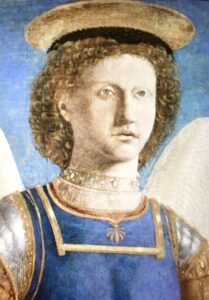
In 1454, the Italian master painter, Piero della Francesca was commissioned to create this masterpiece for the church of Sant’Agostino. Unfortunately the central part of this masterpiece was lost and the four panels of the wings were scattered throughout four museums around the world. Piero della Francesca finished painting of his masterpiece in 1469 at the church of Sant’Agostino in Borgo San Sepolcro (Arezzo). At the end of the 16th century the panels were scattered. And for the first time in the history, as the result of the initiative by the Poldi Pezzoli Museum in Milan, the four scattered pieces from four museums: New York Frick Collection, Lisbon National Museum of the Art, London National Gallery and Washington National Gallery of Art, were brought together in Milan for the exhibition that started from March 20, 2024 and will continue to June 24, 2024.

This unique work of art shows the depth of Piero’s knowledge and his understanding of perspectives and complexity of colors and light . Piero was not only a highly skillful painter but a great mathematician and geometer. His unique paintings demonstrate his rare skills. The visitors have a chance to view Piero’s masterpiece, the four scattered panels of the wings in one visit. It is an emotional moment for those Renaissance art enthusiasts especially those who are very fond of Piero masterpieces. Many art enthusiasts traveled to Italy and went to Milan just to see this masterpiece’s pieces assembled. After the end of the exhibition, the four panels will be returned to the four museums around the world: San Giovanni Evangelista to the NY Frick Collection, Sant’Agostino to the Lisbon National Museum of Art, Sant’Apollonia to the Washington National Gallery and finally, the main part, San Michele Arcangelo to the London National Gallery. The main part of the masterpiece by Piero della Francesca, that is the Saint Michael image, will be sent to the National Gallery in London. The acquisition of the main piece of the masterpiece painted by Italian painter, Piero della Francesca in 1469 goes back to the 19th century England, it took place after the death of Charles Lock Eastlake in Pisa, 1865.
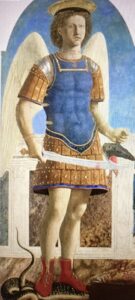
Piero della Francesca in the early years of the Italian Renaissance created many masterpieces, the other notable paintings are “The History of the True Cross” and “Resurrection “. Marita, a recent graduate of Art History who traveled from Barcelona to Milan to visit this masterpiece assembled said: “This is the unique opportunity to view this masterpiece and it should not be missed.” ©CTR Press
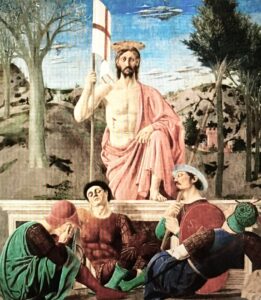
April 2024
April 2024:
The Latest stage of Human Genomics Research
University of California
The director of National Human Genome Research Institute gave a lecture on the latest findings on human genome. He discussed many chapters: molecular biology revolution, human genome project, expansion and maturation of genomics, en route to genomic medicine and finally making genomics mainstream in medicine.
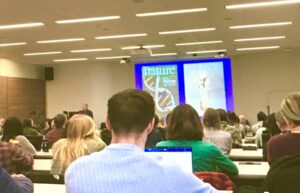
He pointed out that any two peoples’ genome sequences are over 99% identical and less than %1 different. The director explained that the known genome functions are the tips of the iceberg. He discussed continuum of genetic diseases.

The human genome is the complete set of nucleic acids sequences that is encoded as DNA. The regulatory sequences of the human genome control gene expressions. The first human genome sequences was published by Human Genome Project in 2001. There is an important research project that works on the process of human genome variation to the HG functions. Now in 2024, the scientists are focusing on genomic medicine and the way of using genomics to advance knowledge about health and disease. The researchers are working on billions of billions data sets.

The most active institutions in the human genome project are the Whitehead Institute and the Welcome Trust Institute. Anyone on the internet can have access to some of the databases for DNA sequences. The human genome has over 3 billion base pairs. In the recent Annual Review of Genomics , there was an interesting article about the recent discovery about Genetics of Faces; over 300 related genes have been identified so far. Genetic variants have a main role in determining the facial shapes; other factors such as environment and diet can alter the actions of certain genes in the long period.

There are some ethical issues with the genome project such as how the insurance companies can use these data and refuse the insurance to some people with potential health problems. Some researchers are concerned that mapping the human genome could have a profound impact on the perception of the disease and the process of possible cure. ©CTR Press
March 2024:
March 2024:
Fashioning San Francisco,
A Century of Style
De Young Museum
San Francisco, California

This exhibition is about exploring the history of San Francisco through fashion. It is presenting over 100 collections: mainly French, American, Italian and Spanish fashion designers. The enthusiastic visitors have a chance to view some notable examples in the fashion industry and finding out more about “the tradition of self-expression through fashion.”

One of the highlights of the exhibition is displaying the Parisian couture gowns and some American and French haute couture. Lanvin’s evening dresses featuring some elements of the 18th century fashion attracted the attention of some visitors to take pictures and engage in a lively discussions about this style. Jean Patou dresses displaying the easy wearing black dresses in soft silk. It is followed by Jacques Fath design in the similar styles and colors.
The Italian Gianfranco Ferre design by silk satin weave make some visitors to take pictures and one interested visitor, a Fashion student was drawing it for her school project. The elegant Rodarte Collections displaying the evening dresses using natural elements. Cappucci dresses showcasing the suit ensemble in cotton and silk.
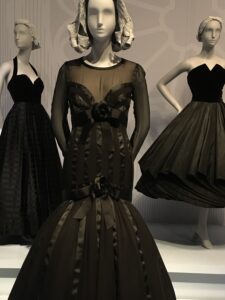
The ambiance of the exhibition room was very lively and positive. The majority of the visitors were females who were interested in finding out more about the major presentations. There were some audio tours available for the viewers who were seeking to learn more about the fashion history.
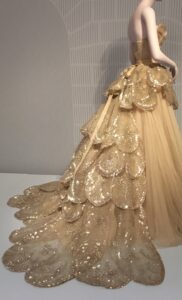
There were some interesting discussions about some modern fashion designers and two students eagerly checking out their websites and comparing them. One of them, Sally stated that her favorite designer has many advantages over the favorite designer of her friend, Rona. And her reason was not the superiority of elegance or style, but the number of followers on the social media! It caused some laughter among the more mature viewers; and one of them a Tech guy who accompanied his wife to the exhibition mentioned that maybe because your favorite designer spend much more on the marketing and continued explaining how some companies create positive reviews and followers for the websites that had already paid them by using “bots”. “They can create hundreds of thousands followers that are not real humans and just “bots”. And the sad part is that the social media community doesn’t care about this false and deceptive behavior. And how naively some people blindly following a social media just because they see the huge number of followers. Unfortunately, so many people choose quantity over quality and their standards have been cheapened and lowered by the social media and at the end of the day they are wondering why they aren’t feeling good!
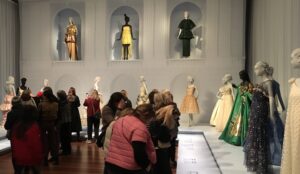
There is no doubt that fashion is interconnected with the economic, social and cultural context of each society and it changes throughout the years. It is also a source of inspiration for the art and a means of displaying different styles and tastes. The classic fashion is very different from the modern one. The 21st century fashion is influenced by the advanced technology and lacks the elegance and simplicity of the classic ones. ©CTR Press

February 2024:
February 2024:
The Met Cloisters
New York
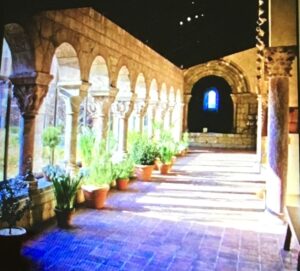
The Met Cloisters is the hidden gem of museums in New York. A large collection of European Medieval artifacts are on display. The artworks from the Mediterranean and European in the fourth century to the Renaissances and some artifacts from early Iron Age and Bronze Age have made this museum especially interesting.
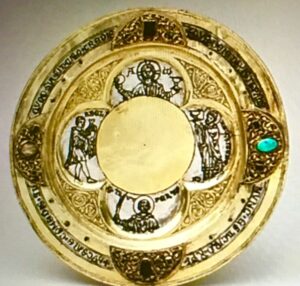
The Cloisters building was designed by Charles Collens in a simplified medieval style. The Gothic Hall exhibiting the finest 16th century collection such as sculptures by Riemenschneider. In total, there are over 5,000 artifacts from Europe mainly from 12th to 16th centuries. The display of the artifacts are arranged thematically to represent the history of the specific periods.
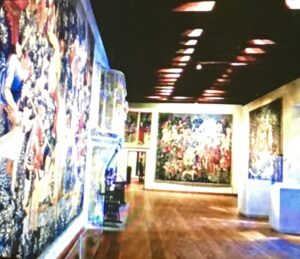
The architecture, the windows, doorways and stained glasses are remarkable. A series of original tapestries have added to the charm and character of the museum. The three gardens in the Cloisters were laid out in 1938 and containing some rare medieval works. The entrance from the upper level of Gothic Hall is lit by stained glass windows on both sides. And on the ground level, the glass panels dates back to the early 14the century. In the Romanesque Hall, there are some columns from the Augustinian church.
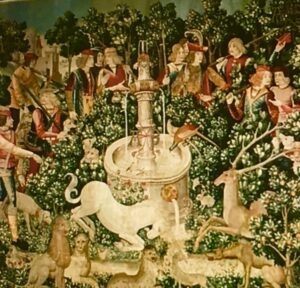
There is an interesting library in the Cloisters that specifically focuses on medieval art and architecture with over 16,000 books and journals. This space is available to the art researchers and academics by appointment.
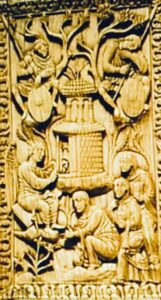
Displaying the art of the Middle Ages and European Renaissance and picturesquely overlooking the Hudson River, atop a tall hill in the northern tip of Manhattan, on a 4 acres Park, providing the visitors with an opportunity to escape the hustle of New York City and immerse themselves in the art and architecture of the Middle Ages in an extraordinary ambiance. ©CTR Press
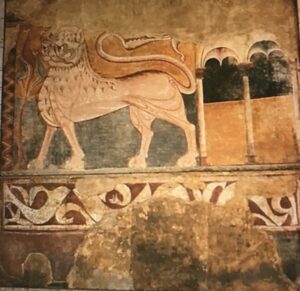
January 2024:
January 2024:
Botticelli Exhibition
Legion of Honor Museum
San Francisco, California
Botticelli Drawings Exhibition featuring some rarely seen drawings and paintings by the magnificent Renaissance artist, Sandro Botticelli. The spiritual power and grace were the dominant elements in the exhibition: Botticelli Drawings and Paintings attracted the visitors from other cities in California , other States and some international visitors to visit the Art Museum of San Francisco, Legion of Honor. The Exhibition has the extraordinary ambiance of the Italian Museums. The exhibition is divided into seven sections: starting with the early 1460s when Botticelli was a pupil of Lippi to his graceful religious paintings of the 1500s.
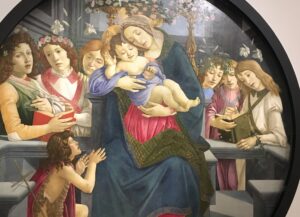
Botticelli (1445-1510) was one of the main painters of Italian Renaissance. He was apprenticed to Fra Filipinos Lippi in 1463. Then in 1472, he took on his first apprentice, the son of Lippi and they created the rare and magnificent works of art together including many Madonna and Child paintings. His paintings of the Madonna and Child usually accompanied by the beautiful singing angels.
Botticelli had a lifelong interest in Dante, the great literary figure in Florence, Italy and the world. He designed many illustrations for Dante’s Divine Comedy. The Divine Comedy consists of 100 cantos and Botticelli provided illustrations and drawings for the Inferno.
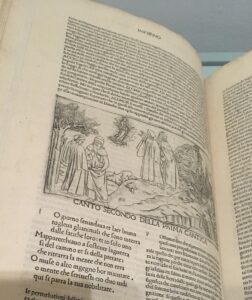
Botticelli had a lifelong interest in Dante, the great literary figure in Florence, Italy and the world. He designed many illustrations for Dante’s Divine Comedy. The Divine Comedy consists of 100 cantos and Botticelli provided illustrations and drawings for the Inferno.
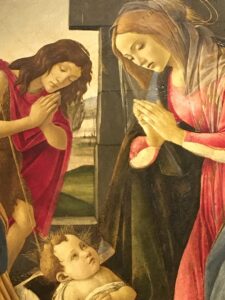
Botticelli was fascinated by Simonetta Vespucci’ beauty, charm and grace. She was an inspiration for him while creating the female figures in his paintings. After she passed away at the age of 23, Botticelli requested to be buried at the foot of her tomb. When he passed away in 1510, his remains were placed as he requested.


One of the rare paintings created by Botticelli and Lippi is the two Five Sibyls in Niches. These two marvelous paintings featuring the total 10 Sibyls: starting with the Persian, and then the Libyan, the Delphic, the Cimmerian, the Erythraean, the Samian, the Cumaean, the Hellespontine, the Phrygian and finally the Tiburtine. The Sibyls were Prophetesses from classical literature BC; they were widely regarded as frenzied women whose talkings were Divine; and according to the later Christian theologians they foretold the Christ’s birth, death and resurrection.

His later drawings depicted the political upheavals of 1490s. The arrival of deeply moralistic Dominican friar, Girolamo Savonarola in Florence made a deep impression on Botticelli and he became one of his followers. Some art critics believe that Botticelli produced no artworks afterwards. But one thing is certain that people should be very careful about what they read online. There are lots of misinformation about the historical figures and artists online. Botticelli is no exception. This misinformation often is carried out by the bots. Sometimes it creates fake quotes and fake references and the links that don’t work. It is insulting to the historical figures, the culture in general and the intellect of the readers too. The information provided by the exhibition’s curators was very helpful and helped the viewer better understand the works of the genius Renaissance artist, the Italian Botticelli. (C)CTR Press His later drawings depicted the political upheavals of 1490s. The arrival of deeply moralistic Dominican friar, Girolamo Savonarola in Florence made a deep impression on Botticelli and he became one of his followers. Some art critics believe that Botticelli produced no artworks afterwards. But one thing is certain that people should be very careful about what they read online. There are lots of misinformation about the historical figures and artists online. Botticelli is no exception. This misinformation often is carried out by the bots. Sometimes it creates fake quotes and fake references and the links that don’t work. It is insulting to the historical figures, the culture in general and the intellect of the readers too.
His later drawings depicted the political upheavals of 1490s. The arrival of deeply moralistic Dominican friar, Girolamo Savonarola in Florence made a deep impression on Botticelli and he became one of his followers. Some art critics believe that Botticelli produced no artworks afterwards. But one thing is certain that people should be very careful about what they read online including Wikipedia. There are lots of misinformation about the historical figures and artists online. Botticelli is no exception. This misinformation often is carried out by the bots. Sometimes it creates fake quotes and fake references and the links that don’t work. It is insulting to the historical figures, the culture in general and the intellect of the readers too. The information provided by the exhibition’s curators was very helpful and helped the viewer better understand the works of the genius Renaissance artist, the Italian Botticelli.
©CTR Press
